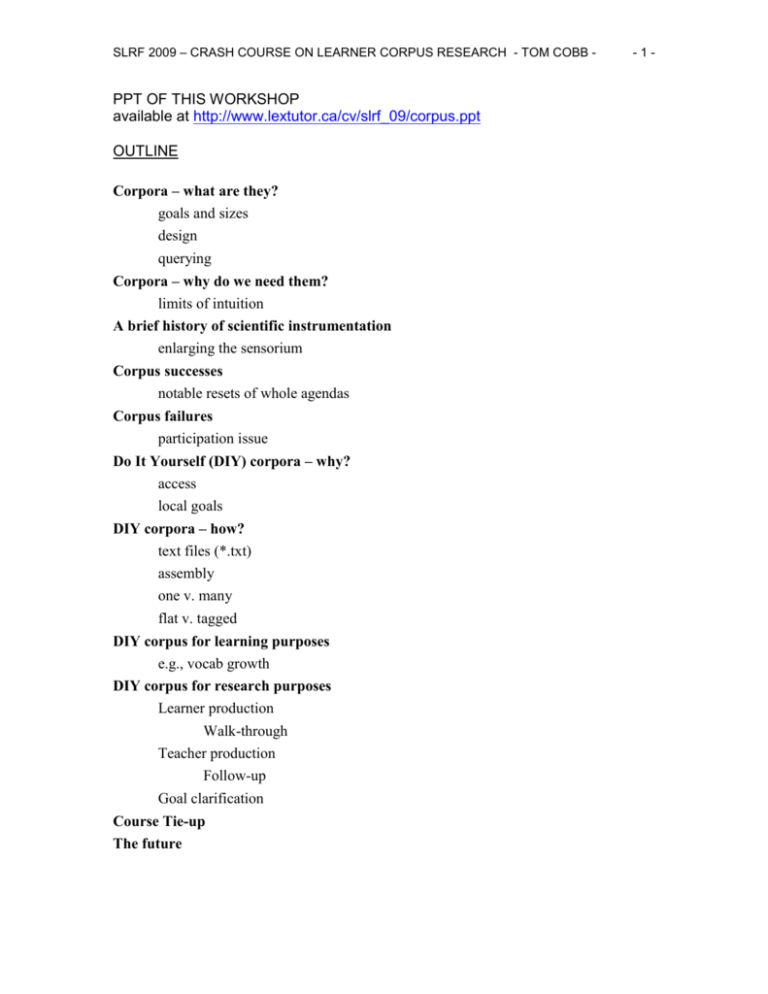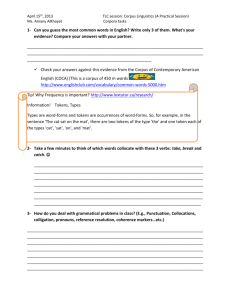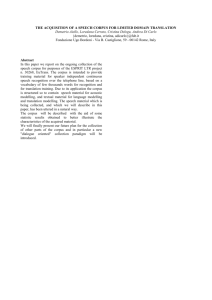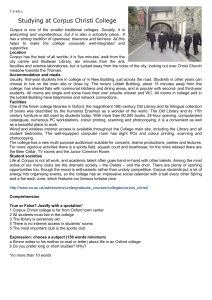
SLRF 2009 – CRASH COURSE ON LEARNER CORPUS RESEARCH - TOM COBB -
PPT OF THIS WORKSHOP
available at http://www.lextutor.ca/cv/slrf_09/corpus.ppt
OUTLINE
Corpora – what are they?
goals and sizes
design
querying
Corpora – why do we need them?
limits of intuition
A brief history of scientific instrumentation
enlarging the sensorium
Corpus successes
notable resets of whole agendas
Corpus failures
participation issue
Do It Yourself (DIY) corpora – why?
access
local goals
DIY corpora – how?
text files (*.txt)
assembly
one v. many
flat v. tagged
DIY corpus for learning purposes
e.g., vocab growth
DIY corpus for research purposes
Learner production
Walk-through
Teacher production
Follow-up
Goal clarification
Course Tie-up
The future
-1-
SLRF 2009 – CRASH COURSE ON LEARNER CORPUS RESEARCH - TOM COBB -
-2-
REFERENCES
(ALSO AT http://www.lextutor.ca/cv/slrf_09.handout.doc for click-on option.)
Julie A. Belz (2004). Learner corpus analysis and the development of foreign language
proficiency. System 32(4), 577-591.
Calper Gold - Centere for Advanced Language Proficiency Education and Research
Graphic Online Learning Diagnostic. Pennsylvania State University.
http://calper.la.psu.edu/corpus_portal/gold.php
Cobb, T. (2008). Necessary or nice? The role of computers in L2 reading. In Z. Han & N.
Anderson (Eds), L2 Reading Research and Instruction: Crossing the Boundaries. Ann
Arbor: University of Michigan Press.
Cobb, T. (2008). Review of T. McEnery, R. Xiao & Y. Tonio (2006), Corpus-based
language studies: An advanced resource book. Canadian Modern Language Review,
64(3) 523-525. http://www.lextutor.ca/cv/review_mcenery.htm
BTW the companion Web pages for this book are not correctly linked: ask Tom.
Cobb, T. (2007). Computing the vocabulary demands of L2 reading. Language Learning
& Technology 11(3), 38-63. [Access http://llt.msu.edu/vol11num3/pdf/cobb.pdf ]
Cobb, T. (2006). Review of Nadja Nesselhauf (2005), Collocations in a Learner Corpus.
Canadian Modern Language Review. 63 (2), xxx-xxxx.
Access http://www.lextutor.ca/cv/nesselhauf.htm
Cobb, T. & Horst, M. (2004). Is there room for an AWL in French? In Bogaards, P. &
Laufer, B. (Eds.), Vocabulary in a Second Language: Selection, acquisition, and testing
(pp. 15-38). Amsterdam: John Benjamins.
Access http://www.lextutor.ca/cv/awl_F.htm
Cobb, T. (2003). Analyzing late interlanguage with learner corpora: Quebec replications
of three European studies. Canadian Modern Language Review, 59(3), 393-423.
Access http://www.lextutor.ca/cv/pdf/learner_corpus.pdf
Cobb, T. (1999). Applying constructivism: A test for the learner as linguist. Educational
Technology Research & Development, xx(xx), yyy-yyy.
Access
Cobb, T. (1997). Corpus & concordance in linguistics & language learning.
(PhD Thesis, Ch 2, Intro to concordancing)
[Access http://www.lextutor.ca/cv/webthesis/Thesis2.html ]
Conrad, S. (Ed.)(2003). TESOL Quarterly Special Corpus and Applied Linguistics
Volume. 37(3), 1-190.
SLRF 2009 – CRASH COURSE ON LEARNER CORPUS RESEARCH - TOM COBB -
-3-
[Access in full http://www.twu.ca/library/tqd_2008/VOL_37_3.pdf ]
Gardner, D. & Davies, M. (2007) Pointing out frequent phrasal verbs: A corpus-based
analysis. TESOL Quarterly, 41(2), 339-359.
Gaskell, D., & Cobb, T. (2004). Can learners use concordance feedback for writing
errors? System, 32(3), 301-319.
Access http://www.lextutor.ca/cv/pdf/concordance_feedback.pdf
Granger, S. (2004). Computer learner corpus research: Current status and future
prospects. In U. Connor & T. Upton (Eds), Applied Corpus Linguistics: A
Multidimensional Perspective (pp. 123-146). Amsterdam & Atlanta: Rodopi.
[Most of it on Google books.]
Granger, S. (2002). A bird’s-eye view of learner corpus research. In s. Granger, J. Hung,
& S. Petch-Tyson, Computer Learner Corpora, Second Language Acquisition and
Foreign Language Teaching (3-36). Amsterdam “ John Benjamins.
Granger, S. (1998). Learner English on Computer. London: Longman.
Greaves, C. Online. ConcApp Corpus Concordance interface similar to Lextutor’s but
running on your own machine, with full instructions and tutorial.
[Access http://www.edict.com.hk/pub/concapp/ ]
Lee, D. Online. Devoted To Corpora. (Best online collection.).
Access http:///personal.cityu.edu.hk~davidlee/devotedtocorpora/CBLLinks.htm
McCarthy, M. (2008). Accessing and interpreting corpus information in the teacher
education context. Language Teaching, 41(4), 563-574.
MICASE – Michigan Corpus of American Spoken English.
Plus tools of analysis. Highly accessible at http://quod.lib.umich.edu/m/micase/ .
Morris, L. & Cobb, T. (2004). Vocabulary profiles as predictors of TESL student
performance. System 32(1), 75-87.
Access http://www.lextutor.ca/cv/vp_predictor.pdf
Ovtcharov, V. , Cobb, T. & Halter, R. La richesse lexicale des productions orales :
mesure fiable du niveau de compétence langagière. Revue Canadienne des Langues
Vivantes, 63(1), 107-125. Access http://www.lextutor.ca/cv/richesse_lexicale.pdf
Robb, T. (2003). Google as a Quick 'n Dirty Corpus Tool
TESL-EJ 7(2) online. Access http://tesl-ej.org/ej26/int.html
Scott, M. 1996. Wordsmith Tools. Oxford: Oxford University Press.
SLRF 2009 – CRASH COURSE ON LEARNER CORPUS RESEARCH - TOM COBB -
-4-
Scott, M. and C. Tribble. 2006. Textual Patterns: Key Words and Corpus Analysis in
Language Education. Amsterdam/Philadelphia: John Benjamins.
Tribble, C. and G. Jones. 1990. Concordances in the Classroom. Harlow: Longman.
Tribble, C. (2008). Review of O’Keefe, A., McCarthy, M., & Crater, R. (2007). From
Corpus to Classroom: Language Use & Language Teaching. London: Cambridge
University Press. In ELT Journal, 62(2), 213-216.
Tribble C (1997) "Improvising corpora for ELT: quick-and-dirty ways of developing
corpora for language teaching" in Melia J & B Lewandowska-Tomaszczyk (ed.) PALC
'97 Proceedings Lodz University Press Lodz
Access http://www.ctribble.co.uk/text/Palc.htm
Lamy M-N. & Klarskov Mortensen H. J. (2009) Using concordance programs in the
Modern Foreign Languages classroom. Module 2.4 in Davies G. (ed.) Information and
Communications Technology for Language Teachers (ICT4LT), Slough, Thames Valley
University [Online]. Access: http://www.ict4lt.org/en/en_mod2-4.htm .
Centre for Corpus Linguistics, Université Catholique de Louvain, Belgium.
http://cecl.fltr.ucl.ac.be/ . (1) Order form for International Corpus of Learner English and
LOCNESS Corpus of Native Speaker Essays (2) List of 400 published Learner Corpus
studies
Sinclair, J. (200x) Reading Concordances: An Introduction. London: Pearson-Longman.
Access concordance lines www.twc.it
Stevens, V. (1995). Concordancing with Language Learners: Why? When? What?
CAELL Journal, 6(2), 2-10
Access: http://www.vancestevens.com/papers/archive/concordance1996.htm









